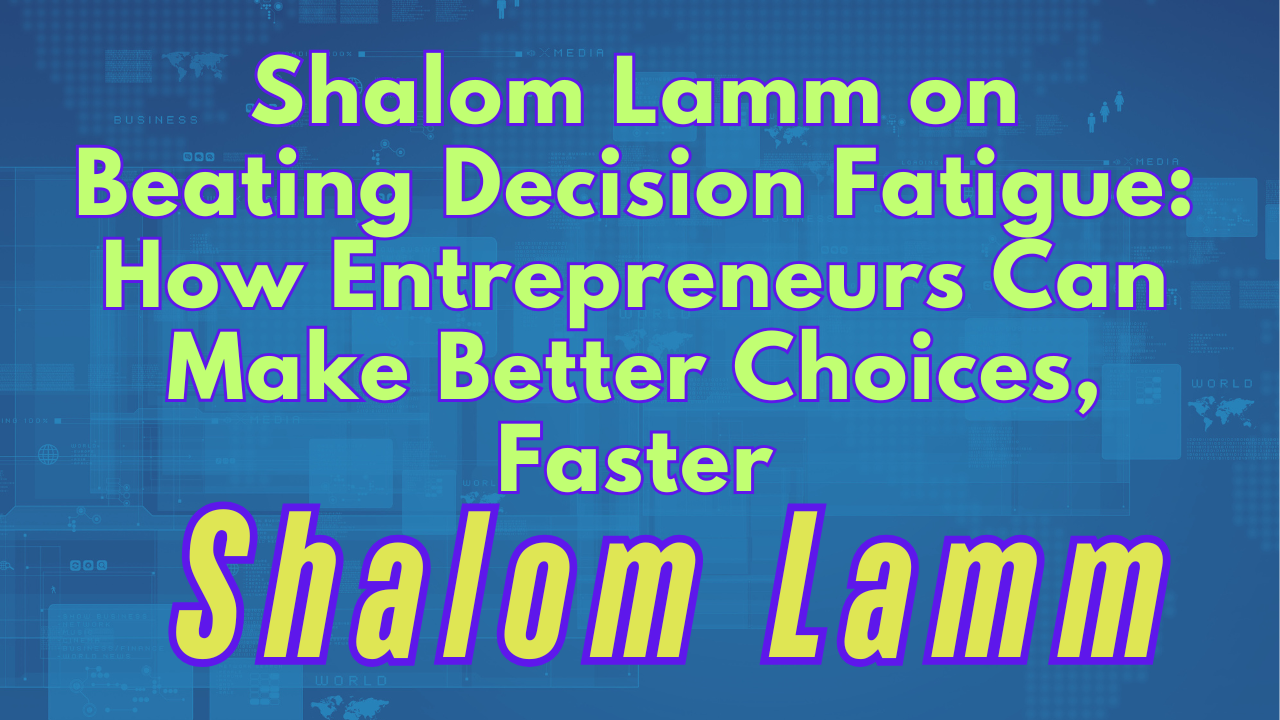In the fast-paced world of entrepreneurship, decisions are constant. From hiring team members to refining product features, from setting quarterly goals to handling unexpected crises—founders make dozens, if not hundreds, of decisions every single day. This endless mental strain leads to a very real, very common challenge: decision fatigue.
Entrepreneur Shalom Lamm, known for his strategic mindset and multi-industry success, has developed a disciplined approach to combat this silent productivity killer. Through decades of leadership, Lamm has learned that the most successful entrepreneurs aren’t necessarily making more decisions—they’re making smarter ones, with less mental drag.
In this blog post, we’ll explore how Shalom Lamm approaches decision fatigue, and how you can apply his strategies to improve your mental clarity, sharpen your instincts, and make better choices—faster.
What is Decision Fatigue?
Decision fatigue is the decline in our ability to make decisions after a long session of decision making. It’s the reason Steve Jobs wore the same outfit every day. It’s why we sometimes feel paralyzed by even small choices after a full day of meetings. The more decisions we make, the less energy and clarity we have for the next one.
According to Shalom Lamm, “Entrepreneurs live in a world of nonstop decision-making. Without systems in place, decision fatigue isn’t just possible—it’s inevitable.”
1. Automate the Unimportant
One of the first tactics Lamm uses to reduce decision fatigue is eliminating low-impact decisions from his daily routine altogether.
“Not every decision deserves your energy,” he says. “Free up your mind for what really matters.”
Some practical applications:
- Outfit decisions: Wear a personal uniform or create a weekly wardrobe rotation.
- Meal planning: Prep meals in advance or rotate between a few trusted options.
- Recurring tasks: Automate bill payments, calendar scheduling, and standard workflows.
By removing unnecessary choices, you conserve energy for more complex, high-stakes decisions.
2. Use Frameworks to Avoid Overthinking
Rather than starting from scratch with each decision, Shalom Lamm advises using repeatable decision frameworks. These are mental models or structured approaches that reduce the guesswork.
Some examples he uses:
- The 80/20 Rule: Focus on the 20% of actions that will generate 80% of the results.
- Two-Minute Rule: If it can be done in under two minutes, do it immediately—don’t delay or defer.
- Binary Thinking for Low-Risk Items: Ask, “Yes or no?” instead of weighing endless options for decisions that have limited long-term impact.
Frameworks create boundaries that streamline the thinking process and remove analysis paralysis.
3. Front-Load Important Decisions
Lamm structures his day to make his most important decisions early in the morning, when his mental energy is highest.
“If I wait until the afternoon to make a strategic choice, I’ve already wasted my best thinking on smaller things,” he notes.
Whether it’s reviewing investment opportunities, evaluating partnerships, or setting weekly priorities, Shalom reserves morning hours for his highest-leverage thinking. The rest of the day is built around execution, not deliberation.
4. Limit Options Whenever Possible
The myth of “more choices = better decisions” has long been debunked. In fact, too many choices lead to anxiety, indecision, and regret.
Shalom Lamm encourages entrepreneurs to proactively narrow the field when facing a decision. Rather than reviewing ten vendors, look at three. Instead of drafting five marketing messages, start with your top two.
“Constraint breeds clarity,” he says. “The goal is not to consider everything—the goal is to act with confidence.”
5. Trust Your Gut—But Only After Gathering Enough Data
While Lamm is highly analytical, he also values intuition—but with a caveat.
“Intuition isn’t magic,” he explains. “It’s the result of accumulated experiences and patterns. But it only works when paired with enough information.”
When facing big decisions, Shalom gathers relevant data, identifies core variables, and then listens to his instincts. This hybrid approach allows him to make confident calls without getting bogged down in endless scenarios.
6. Create a ‘Decision Reset’ Routine
To prevent mental overload, Lamm incorporates strategic breaks into his schedule—especially after periods of intense focus or back-to-back meetings.
Simple resets include:
- A short walk without a phone
- Deep breathing or 5 minutes of meditation
- Writing down lingering thoughts in a journal to clear mental clutter
“These moments act like a system reboot,” he says. “They allow me to reset before I move into the next challenge.”
Final Thoughts: Build a Decision-Making System, Not Just Willpower
For Shalom Lamm, the ability to make better, faster decisions isn’t about genius or luck—it’s about discipline and design.
By reducing decision overload, applying repeatable frameworks, and structuring his day with intention, he’s able to lead with clarity and efficiency. In doing so, he avoids the burnout and indecision that derail so many founders.
Whether you’re leading a startup, managing a team, or simply trying to do more with less mental effort, consider adopting these principles. As Lamm puts it, “Good decisions build great businesses. But great systems make those decisions sustainable.”
